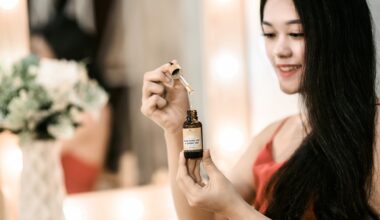Introduction:
From the aromatic chambers of Cleopatra in Egypt to the sacred rituals of Indian brides, hair oiling has been more than just a beauty regimen. For centuries, it’s been an act of self-care, a tradition passed down through generations. Yet, as we step into the modern age, a cloud of skepticism forms around this ancient practice. Is hair oiling just a vestige of the past, or does it hold merit in the age of salon treatments and hair serums? As someone with over 20 years of experience in hairstyling, I can vouch for the transformative power of oils. This article embarks on a journey to unearth the science, benefits, and best practices of hair oiling in today’s world.
Key Takeaways:
- The Undeniable Science: Get acquainted with the intricate anatomy of hair and the critical role of oils in maintaining its health and vibrancy.
- Dive Deep into the Oil Reservoir: A comprehensive look at different oils, their unique benefits, and who they’re most suited for.
- Craft Your Oiling Ritual: Whether it’s a luxurious hot oil massage or a quick post-shower application, discover the best ways to incorporate oils into your hair care routine.
- Demystifying Oils: Navigate through common misconceptions about hair oiling, and arm yourself with knowledge and precautions to make the most out of your oiling experience.
The Science Behind Why Hair Needs Oil:
Hair Anatomy 101:
Every strand of hair on our head is a marvel of nature, composed of multiple layers, each serving a unique purpose. The outer layer, known as the cuticle, is like a protective shield made of overlapping cells. Beneath this lies the cortex, which carries the pigment determining hair color and is largely responsible for the hair’s strength and elasticity. At the core, we find the medulla, though it’s often absent in thin hair.
Now, here’s where it gets fascinating. Our scalp naturally produces an oil called sebum. This isn’t some evolutionary oversight; it’s nature’s own conditioner. Sebum helps in maintaining the hydration of the hair shaft, giving it that healthy shine and protecting it from external damage.
The Modern Lifestyle’s Impact:
While nature had equipped our hair with its defense mechanism in the form of sebum, the modern lifestyle, unfortunately, is like a relentless army against it. Pollution is a silent yet potent adversary, making hair dull and brittle. Those luxurious lathers from shampoos? Many of them strip the hair of its natural oils, especially if they contain harsh sulfates. And let’s not forget about the allure of heat styling, which, while providing those perfect curls or that sleek look, rob the hair of its natural moisture.
Replenishing with Oils:
Given the daily wear and tear, it becomes evident that our hair requires more than just what our scalp can provide. This is where external oiling enters the scene. Think of it as a replenishment. Oils, especially those that mimic the properties of sebum, penetrate the hair shaft, offering deep nourishment. They seal in the moisture, counteract the damage caused by external factors, and offer a protective barrier. The result? Hair that isn’t just moisturized on the outside but nourished from within.
Before we move on to explore the vast reservoir of oils and their unique benefits, it’s essential to appreciate the delicate balance of science and nature at play when it comes to our hair. With the foundation laid, we’re ready to dive deep and uncover the myriad oils that promise to transform hair health.
Types of Oils and Their Specific Benefits:
Coconut Oil:
Long hailed as the ‘elixir for hair’, coconut oil has been at the forefront of hair care in many cultures. Its magic lies in its ability to penetrate the hair shaft deeply.
- Deep Moisturizing Properties: Rich in fatty acids, it binds to the hair proteins, ensuring reduced protein loss during washing.
- Ideal for: Particularly beneficial for damaged and bleached hair. Regular application can lead to noticeably softer and shinier locks.
Argan Oil:
Often dubbed ‘liquid gold’, argan oil, native to Morocco, is packed with beneficial nutrients like vitamin E and fatty acids.
- Vitamins and Antioxidants Galore: These elements make it a powerhouse for taming frizz, promoting shine, and ensuring overall hair health.
- Ideal for: Perfect for those battling frizzy, unmanageable hair, or simply seeking a lustrous sheen.
Jojoba Oil:
What makes jojoba oil so special is its close resemblance to the natural sebum our scalp produces.
- Closest to Hair’s Natural Sebum: It doesn’t just sit on the surface but deeply hydrates, regulating oil production and ensuring balanced moisture.
- Ideal for: Scalp treatments, particularly for those with an imbalanced scalp (too oily or too dry).
Olive Oil:
A staple in Mediterranean cuisine, olive oil also boasts tremendous benefits for hair.
- Deep Penetrative Moisture: Its rich vitamin content and fatty acids make it an excellent conditioner, penetrating the hair shaft and retaining moisture.
- Ideal for: Those struggling with dry, brittle hair. It acts as a natural conditioner, leaving hair feeling soft and supple.
Other Beneficial Oils:
- Almond Oil: Rich in vitamins A, B, and E, it’s perfect for adding shine and softness while strengthening hair from within.
- Castor Oil: Its ricinoleic acid content promotes hair growth, making it a favorite for those looking to boost thickness and volume.
- Grapeseed Oil: Lightweight and non-greasy, it’s a boon for those with naturally oily hair, offering hydration without weighing it down.
Oils are nature’s gift, and as we can see, there’s an oil for every hair concern. But knowing which oil to use is just the beginning. The real transformation begins when we know how to incorporate them into our routines, which brings us to our next section: crafting the perfect oiling ritual.
Crafting the Perfect Oiling Routine:
Timing is Everything:
Overnight Treatment: For those looking to give their hair a deep-conditioning treatment, applying oil and letting it stay overnight can work wonders. It allows the oil to penetrate deeply into the hair shaft, ensuring maximum benefits. But remember, a light hand is crucial. Excessive oil can make washing a chore.
Pre-Wash Ritual: If you’re short on time or simply don’t like the feeling of oily hair, applying oil an hour or two before washing is a great alternative. It offers protection against the stripping effects of shampoos, especially if they’re on the harsher side.
Post-Wash Serum: Some oils, particularly lightweight ones like argan or grapeseed, can be used as a post-wash serum. Just a few drops on damp hair can help in detangling, reducing frizz, and adding a lustrous sheen.
The Technique Matters:
Start at the Scalp: Begin by massaging the oil into the scalp. This not only nourishes the roots but also promotes blood circulation, encouraging healthy hair growth.
Work Your Way Down: After the scalp, focus on the mid-lengths and ends of the hair, especially if they’re prone to dryness. For even distribution, using a wide-toothed comb can be beneficial.
Hot Oil Treatment: Warm the oil slightly (ensure it’s comfortably warm, not hot) before applying. The warmth increases blood circulation to the scalp and allows for better absorption of the oil’s nutrients.
Less is More:
Contrary to popular belief, drenching your hair in oil isn’t the best approach. Using too much can weigh the hair down, making it look greasy and flat. Start with a smaller quantity and add more if needed.
Consider Mixing Oils:
No one said you had to stick to just one oil! For instance, if you’re looking for shine and hair growth, a mix of almond and castor oil could be your potion. It’s about finding the right concoction that addresses your hair’s unique needs.
Washing Off:
Always use a mild, sulfate-free shampoo when washing off the oil. Sulfates can strip the hair of its natural oils, negating the benefits of the oiling ritual. Consider conditioning the ends for added softness.
By now, you should be armed with the knowledge to craft a bespoke oiling ritual tailored to your hair’s needs. However, as with all things beauty, there are misconceptions and myths floating around, waiting to ensnare the unaware. In our next section, we will embark on a mission to demystify the world of hair oils.
Demystifying Common Myths and Precautions:
Myth 1: The More Oil, the Better.
Reality: As previously mentioned, it’s essential to use oil in moderation. Over-saturating the hair can lead to product buildup, making hair look greasy and weighed down. It also can make it harder to wash out, leading to excessive use of shampoo, which can strip the hair of its natural oils.
Myth 2: Oiling Can Solve All Hair Problems.
Reality: While oiling is beneficial, it’s not a cure-all. For instance, oiling can’t reverse hair graying or cure alopecia. It’s crucial to set realistic expectations and understand that oiling is one part of a holistic hair care routine.
Myth 3: All Oils Work the Same Way.
Reality: Every oil has its unique composition and offers specific benefits. For example, coconut oil might be excellent for someone with dry hair, but it might weigh down someone with oily hair. It’s about finding the right fit for your hair type and needs.
Precaution 1: Patch Test.
Before trying out a new oil, always conduct a patch test to ensure you don’t have any allergic reactions. Apply a small amount behind your ear or on your wrist and wait for 24 hours. If there’s no reaction, it’s generally safe to use.
Precaution 2: Mind the Temperature.
While hot oil treatments can be beneficial, it’s vital to ensure that the oil isn’t too hot. Excessively hot oil can damage the hair and even burn the scalp.
Precaution 3: Be Gentle When Washing Off.
When washing out the oil, be gentle. Aggressively rubbing the hair can lead to breakage. It’s best to use lukewarm water (as hot water can strip away essential oils) and gently massage the scalp and hair with a mild shampoo.
The realm of hair oils is vast and full of potential. But as with most things, knowledge is power. By understanding the nuances, setting the right expectations, and being aware of potential pitfalls, you can harness the full potential of oils and pave the way for lustrous, healthy locks.
In our final segment, we’ll touch upon a crucial aspect: the incorporation of hair oils into daily routines, ensuring a holistic approach to hair health.
Incorporating Hair Oils into Your Daily Routine:
Morning Ritual:
Quick Oil Massage: If you’re a morning person, consider starting your day with a 5-minute scalp massage. You don’t need a lot of oil—just a few drops. This not only wakes you up but boosts blood circulation, ensuring better nutrient delivery to your hair follicles.
Lightweight Oil as a Styling Agent: If you’re wary of hair gels and sprays, a few drops of lightweight oil like argan or grapeseed can help tame flyaways and add a natural shine to your hair.
Nighttime Ritual:
Deep Conditioning Treatment: At least once a week, indulge in an overnight oiling session. It gives the oil ample time to work its magic. Remember to protect your pillow with an old towel or a hair cap.
Comb to Distribute: After oiling, use a wide-tooth comb to ensure even distribution. It also helps in detangling and prepping your hair for the next day.
Post-Wash:
Serum Replacement: Ditch the commercial serums and use a few drops of oil on damp hair. It acts as a natural barrier, protecting your hair from heat and environmental damage.
For Curly Haired Beauties: Oils can be a boon, especially for those with curly hair. They help define the curls, reduce frizz, and add a lovely sheen. Jojoba and almond oil are particularly beneficial.
Weekly Ritual:
Hot Oil Treatment: Once a week, or at least bi-weekly, treat your hair to a hot oil treatment. It deep conditions, making your hair soft, shiny, and manageable.
Mix and Match: Don’t be afraid to experiment. If your hair feels dry, add a few drops of olive oil to your regular coconut oil. If you’re looking for shine, mix in some argan oil. The combinations are endless.
Pro Tips for Maximum Benefit:
Avoid the Roots: If you have an oily scalp, avoid applying oil directly to the roots. Focus on the lengths and ends.
Dilution for Essential Oils: If you’re keen on adding essential oils (like tea tree or lavender) for added benefits, remember they are potent. Always dilute them with a carrier oil.
Wash Routine: Pay attention to your wash routine post oiling. Always use cold to lukewarm water and consider investing in a sulfate-free shampoo for a gentle cleanse.
The beauty of hair oils lies in their versatility. Whether you have 5 minutes or an hour, there’s always a way to incorporate them into your routine. Regularly oiling, combined with a balanced diet and proper hair care, can lead to beautiful, healthy tresses that not only look good but feel amazing too.
To wrap up, it’s crucial to remember that everyone’s hair is different. What works wonders for one might not for another. The journey is all about understanding your unique hair type and needs and finding the right oils and techniques that resonate.
Conclusion:
Taking care of our hair is a journey that spans a lifetime. In today’s world, where pollutants, stress, and lifestyle challenges constantly assail our tresses, returning to nature’s age-old remedies offers a respite. Oils, with their nourishing properties, have been our allies for centuries, ensuring that our hair remains a crowning glory.
As we’ve delved into the world of hair oils, it’s evident that they offer more than just superficial benefits. From ensuring a healthy scalp to providing individual hair strands with the nutrients they crave, oils are indispensable. But like all good things, the key lies in moderation, understanding, and customization.
So, the next time you reach out for that bottle of oil, remember it’s not just about the act of oiling. It’s a ritual, an embrace of nature, and most importantly, an act of self-love. Treat your hair with kindness, be patient, and the results will not only reflect in your lustrous locks but also in the newfound confidence that radiates from within.
Remember, your hair tells a story; make sure it’s a story of care, love, and radiance.






